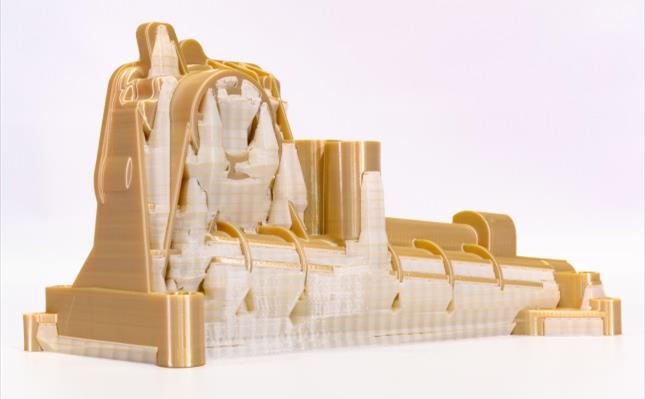SABIC unveiled yesterday the AMS31F filament designed for FDM technology. The new filament of the specialist in chemistry maintains rigidity during the printing process. Moreover, it would also facilitate the post processing stage thanks to an easy removal of scaffolding at room temperature.
The new filament can be used with the producer’s ULTEM™ AM9085F filament, a high-performance polyetherimide (PEI) material. Acknowledged for its high heat resistance and mechanical strength, the latter is exploited by demanding industries (aerospace, automotive, oil, gas and tooling). Until today, the producer mostly featured its materials dedicated to the healthcare environment.
“Using structural supports to print parts with complex geometries is essential, but it can also be quite challenging,” said Keith Cox, senior business manager, Additive Manufacturing, SABIC. “Removing traditional supports from the finished part often involves time-consuming processes that can negatively impact productivity and quality. By offering a complementary support material for our ULTEM™ AM9085F filament, SABIC is providing a complete material solution that helps customers save time and effort. Additionally, the ease of support material removal provides part designers greater flexibility in defining print orientation to optimize part performance.”
Issues encountered during the removal process are usually highlighted when it comes to metal AM processes. By laying emphasis on that, SABIC reminds that such type of issue might concern all types of AM technologies.
Not to mention the various steps that might be achieved at the software level, one notes that the operator gains in flexibility when he has to define part orientation. In fact, the ease of removing the AMS31F support filament removes some constrains and enables the optimization of print efficiency.
The company explained in its press release that “unlike competitive support materials that often require reheating to facilitate removal, SABIC’s AMS31F filament easily separates at room temperature, reducing post-production time. The filament’s white color provides a sharp contrast to the amber color of ULTEM™ filament, which allows operators to more quickly identify the structures to be removed.”
For further information about 3D Printing, follow us on our social networks and subscribe to our newsletter
Would you like to subscribe to 3D Adept Mag? Would you like to be featured in the next issue of our digital magazine? Send us an email at contact@3dadept.com






